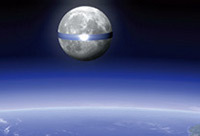Artificial air to be created in lunar atmosphere for moon colonists
The LAMP spectrometer installed on board the Lunar Reconnaissance Orbiter station allowed scientists to study the range of substances contained in the atmosphere of the Moon. In particular, it was found that the lunar atmosphere contained helium and argon. The first analyses of the spectrum were made in 1972 as part of the LACE project that was executed by Apollo 17 mission.

Forty years ago, Apollo equipment determined that the amount of lunar helium grows at nighttime. Perhaps this is because the colder atmosphere in the dark time of the lunar day increases the concentration of atoms of this gas at low altitudes.
Although the main objective of LAMP is to display the lunar surface, researchers decided to explore the remote ultraviolet radiation above the Earth's satellite. The presence of helium in the lunar atmosphere was finally confirmed after Apollo orbited the Moon more than fifty times. The equipment managed to suppress the background interplanetary noise (helium may also be present in outer space).
"The question now becomes, does the helium originate from inside the moon - for example, due to radioactive decay in rocks - or from an exterior source, such as the solar wind?" Alan Stern of the Southwest Research Institute in Boulder, Colo., said.
In addition, researchers will have to figure out how helium is distributed on different latitudes.
Another mystery of the Moon is connected with its ionosphere. The first facts that proved the existence of the lunar ionosphere were obtained in the 1970s, when Soviet orbital probes Luna-19 and Luna-22 discovered a layer of charged particles tens of kilometers above the lunar surface. The layer contained up to one thousand electrons per cubic centimeter. Afterwards, the information about the presence of the dense ionosphere around the Moon was confirmed. However, it was absolutely not clear where it came from and how it appeared. Indeed, the lunar atmosphere is billions of times less dense than that of the Earth.
For example, the ionosphere of our planet is a layer of ionized gas that comes from air particles when exposed to sunlight - ultraviolet. The ionosphere is very important for life on Earth. In particular, it reflects radio waves, affecting communication and navigation. Ionospheric perturbations may lead to malfunctions in the work of GPS devices.
As we can see, one needs air to create the ionosphere. The Moon has practically no atmosphere, at least the atmosphere in our perception of this notion. However, a small amount of gas seeps out onto the surface of the satellite from the lunar interior. The gas appears as a result of radioactive decay inside the Moon and because of the impact of the solar wind. The content of gas at the surface of the Moon at "night" does not exceed 200,000 particles per 1 cubic centimeter.
During the "day," it doubles due to the degassing of the soil. This concentration corresponds to the state of high vacuum, so the surface of the Moon during the day is heated up to +120 degrees Celsius. At night or even in the shade, the surface is cooled down to -160 degrees. The gaseous blanket around the Moon is so thin that it is commonly known as exosphere, not atmosphere. Naturally, there is no place for ionosphere in such conditions. However, it exists!
Astrophysicists were racking their brains over the lunar ionosphere for 40 years. Only recently, Tim Stubbs of NASA's Goddard Space Flight Center Goddard, put forward a surprising hypothesis: the lunar ionosphere is created from moondust! According to Stubbs, the astronauts of Apollo 15 observed a mysterious glow on the horizon of the Moon. It could be caused by the ionization of dust particles that were glowing in the rays of the rising or setting sun. The scientist believes that the electric charge that occurs during the process is enough to maintain the ionosphere. Needless to say that there is more than enough dust on the Moon.
Not so long ago, a group of Cambridge chemists led by Derek Fray developed a device that could extract oxygen from the lunar soil - regolith. The name refers to the mixture of fine dust and rocky debris formed as a result of meteor impacts.
Derek Fray and his colleagues suggested a method based on the electrochemical process developed to produce pure metals and alloys from the oxides contained in regolith. This alloy is used as the cathode, whereas carbon plays the role of the anode.
If such soil-to-oxygen converters are mounted on the entire surface of the Moon, potential colonists from Earth will have something to breathe in spite of the fact that the satellite has no livable atmosphere of its own.
Irina Shlionskaya
Pravda.Ru
Subscribe to Pravda.Ru Telegram channel, Facebook, RSS!


